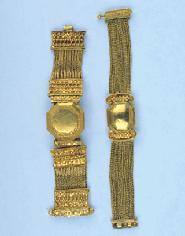


|
Thewa | 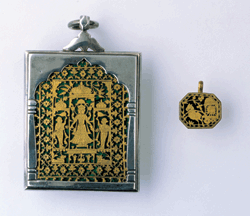 Left: Pendant With Vishnu fanned by Attendants Right: Pendant With the Sun God Surya Pratapgarh, Rajasthan; 19th century. Gold on green glass. |
Molds Indian jewelers use molds in several ways. A wax form may be cast in a mold, then placed in sand, and finally melted away, leaving an impression in the sand into which gold is poured. Alternatively, sheet gold may be placed over a mold and wax used to press the gold into the mold. |
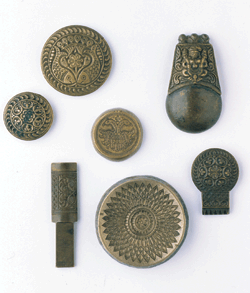 Cast brass jewelry molds, India; 19th–early 20th century. |
Lac Lac is an insect secretion indigenous to India. It has been used in almost every aspect of Indian jewelry manufacture. An ornament is held in lac when it is being set with gems or enameled. Indian jewelers also place lac inside ornaments to hold their shapes, a practice that dates back to the third to second millennium B.C.E. Repoussé To create a repoussé design, sheet metal is placed over a soft substance such as lac or resin. The design is then hammered into relief.
|
|
Granulation Surface tension causes small drops of gold to form perfect balls; these are bonded, through a chemical process, to the surface of an ornament, often in large numbers.
|
|
Kundun Kundun is a technique of gem setting developed at the Mughal court. A gem is placed on lac, a natural resin. Around the gem and over the lac, a jeweler layers many leaves of 24-carat gold, filling the area around the gem to hold it in place. |
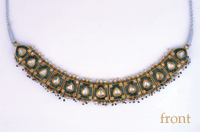 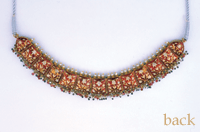
Gold, diamond, and pearl necklace adorned with tiny florets on reverse (diamonds set with the kundun technique) Tamil Nadu; 19th century. |
Enamel is a glasslike substance colored with metallic oxides. Most enamelwork in India is champleve. According to the champleve method, the jeweler first carves out the gold surface of an object. He leaves the outlines of his design raised and may carve a subtle texture or pattern, such as the veins of leaves. He applies the enamel in paste-like form and then fires it. The red so often used in northern Indian enamelwork is particularly fragile and must be fired twice. Enamels can be opaque or transparent. The Indian enameler's palette includes white, blue, green, red, black, turquoise, peach, yellow, and pink.
| |
Gem cutting Indian
gem cutting is characterized by a preference for size over clarity.
While Europeans value clarity, cutting away imperfections and faceting
a gem for maximum brilliance, Indians value the weight of a stone
and leave many in their natural forms, only polishing them. Gems
are sometimes bored to make beads and carved with floral and figurative
designs. The Mughals also created a fashion in India for engraving
short verses, Koranic passages, and names into cherished gems
Click here for more information on jewelry Construction
& Links.
|
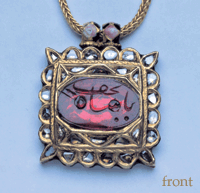 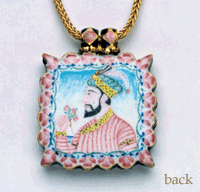
Pendant with large engraved spinel (front) and image of a Mughal ruler (back) Pendant and enamel: North India; 19th century Spinel: probably engraved in the mid to late 18th century. |
